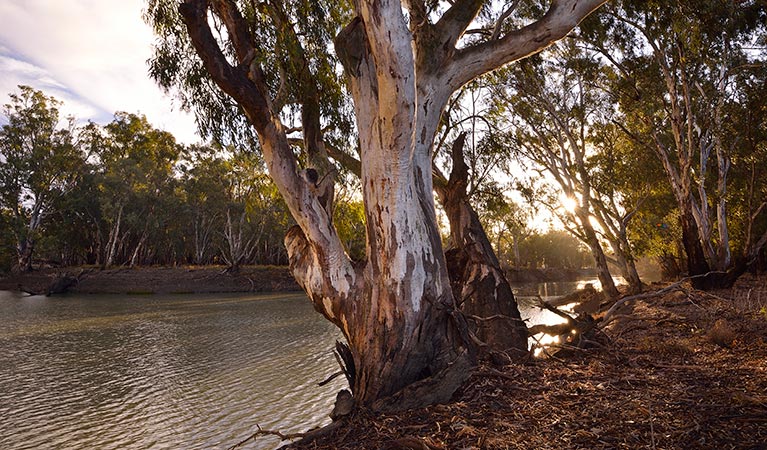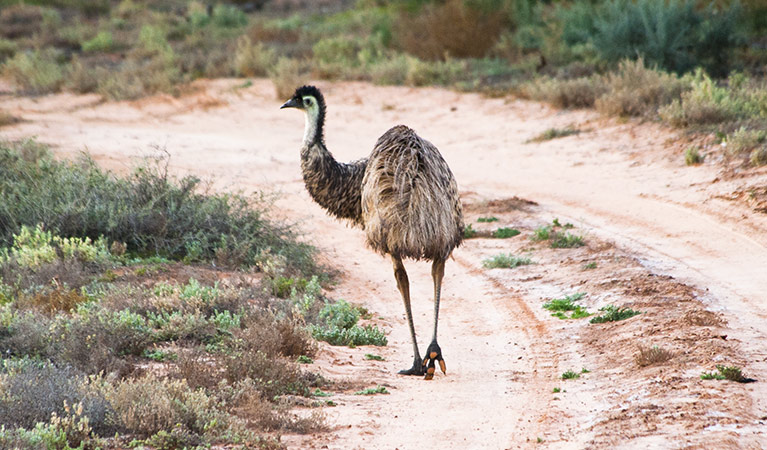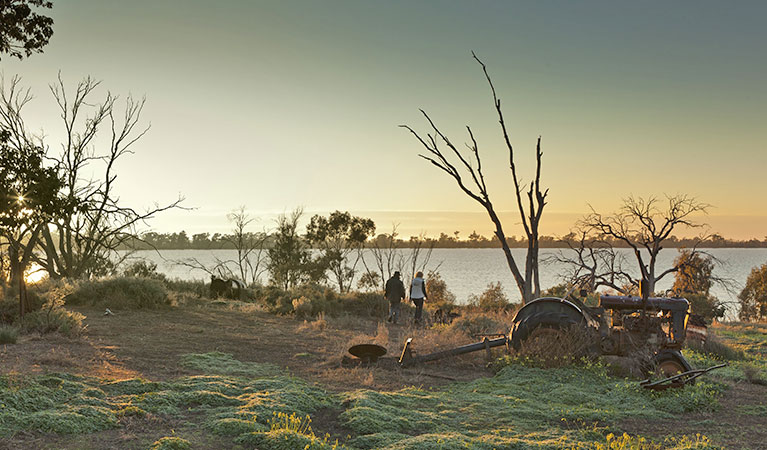Overview
Short yet rewarding, Yanga Lake walking track is a family friendly lakeside walk offering scenic wetlands views and spectacular birdwatching in Yanga National Park.
- Where
- Yanga National Park in Murray-Riverina
- Distance
- 1km loop
- Time suggested
- 30min - 1hr
- Grade
- Grade 5
- What to
bring - Drinking water, sunscreen, hat, clothes for all weather conditions
- Please note
- Check the weather before you set out as the road to Yanga walking track can become boggy when it rains
- There is limited mobile reception in this park
For a beautiful lakeside walk that combines impressive scenic views and superb birdwatching, head for Yanga Lake walking track. This short track traces part of the eastern shoreline to link some of the most scenic features of Yanga National Park. Near Yanga Homestead, it’s an ideal introduction to the tranquil beauty of the wetlands for families, school groups and nature lovers.
The steep and rough track descends from Yanga Lake viewing deck through majestic river red gums and river coobas to the very shores of the immense lake. Enjoy a leisurely picnic as you soak in the natural beauty and serenity.
Spring and Autumn are excellent times to visit as bird activity is at its peak. However, there’s birdlife all year round including pelicans, cormorants and white-bellied sea eagles. For a more immersive birdwatching experience stop by Yanga Lake Red Gum bird hide.
Nearby
-

Yanga Historic Refrigeration Shed
Yanga Historic Refrigeration Shed is located at Yanga Homestead. It’s a fascinating way to learn about the history of an iconic station in Australia’s outback.
Map

Map legend

Local alerts
For the latest updates on fires, closures and other alerts in this area, see https://www.nationalparks.nsw.gov.au/things-to-do/walking-tracks/yanga-lake-walking-track/local-alerts
General enquiries
- National Parks Contact Centre
- 7am to 7pm daily
- 1300 072 757 (13000 PARKS) for the cost of a local call within Australia excluding mobiles
- parks.info@environment.nsw.gov.au
Park info
- in Yanga National Park in the Murray-Riverina region
Yanga National Park is open Sunrise to Sunset but may have to close at times due to poor weather or fire danger.
Yanga Homestead Precinct is open 8.30am - 4.30pm.
Visitor info
All the practical information you need to know about Yanga Lake walking track.
Track grading
Features of this track
Distance
1km loop
Time
30min - 1hr
Quality of markings
Sign posted
Experience required
No experience required
Gradient
Short steep hills
Steps
No steps
Quality of path
Rough unformed track
Getting there and parking
Yanga Lake walking track is in the Homestead precinct of Yanga National Park. To get there:
- From Balranald, travel east along Sturt Highway for 7km.
- Turn right into Yanga picnic area just over Yanga Creek
- Turn left at the Yanga National Park sign and drive 2km along unsealed road to Yanga Homestead, where the track begins.
Parking
Parking is available at Yanga Homestead.
Best times to visit
The locals will tell you it can get pretty hot out this way, so you may wish to time your visit to avoid the summer heat. Temperatures during autumn, winter and spring are more moderate - just be sure to check the forecast as roads can become inaccessible in wet weather.
Spring
A great time to see the woodland birds - be sure to bring your binoculars.
Weather, temperature and rainfall
Summer temperature
Average
15°C and 34°C
Highest recorded
47.7°C
Winter temperature
Average
4°C and 17°C
Lowest recorded
-4.8°C
Rainfall
Wettest month
May to October
Driest month
January to March
The area’s highest recorded rainfall in one day
93.3mm
Maps and downloads
Prohibited
Pets
Pets and domestic animals (other than certified assistance animals) are not permitted. Find out which regional parks allow dog walking and see the pets in parks policy for more information.
Smoking
NSW national parks are no smoking areas.
Learn more
Yanga Lake walking track is in Yanga National Park. Here are just some of the reasons why this park is special:
A pioneering history

Some of the country's renowned early explorers passed through this area, and you have the opportunity to retrace their steps. Explorers included John Oxley in 1817, Charles Sturt in 1830, Major Thomas Mitchell in 1836 and Burke and Wills in 1860. Visit nearby Balranald to see where Bourke and Wills' party crossed the Murrumbidgee by the Mayall Street punt, then camped by the river in front of Balranald Inn.
- Yanga Woolshed Explore Yanga Woolshed in Yanga National Park. When constructed in the late 1800s, the woolshed was the Riverina’s largest. It offers an insight into Australia’s pastoral history.
- Yanga Woolshed picnic area Located in Yanga National Park, near Balranald in the Riverina, Yanga Woolshed picnic area is an excellent place for a barbecue or spot of fishing on the Murrumbidgee.
A remarkable landscape

Yanga National Park is blessed with 170km of Murrumbidgee River frontage. The river is great for canoeing or swimming, and its banks provide excellent fishing and camping spots. On your visit, you'll notice the landscape's unique contrast of black and red country. Vegetation on its black soil floodplains comprises river red gum forest and swampland, while its red soil varies from grass to saltbush to woodlands. Come and spot the differences yourself.
- Regatta Beach picnic area Enjoy swimming, boating, birdwatching and paddling in the tranquil lakeside waters of picturesque Regatta Beach picnic area in Yanga National Park, near Balranald.
Rich in Aboriginal culture

Yanga National Park has a rich Aboriginal history; the park provided resources including waterbirds, fish, and yabbies as well as shelter and medicine. Look closely at the trees in the floodplain where you're visiting – many bear the bark-stripping scars from canoe-making. Today, local Aboriginal people remain connected with Yanga National Park through employment or community involvement.
- Yanga Lake viewing deck Yanga Lake viewing deck offers spectacular birdwatching and scenic wetland views in Yanga National Park, near Balranald.
Unbeatable for birdwatchers

A large number of migratory birds rely on the Yanga National Park red gum wetlands. The park is a great place to see egrets, herons, spoonbills and glossy ibis using the wetlands as a resting, foraging and breeding ground. Walk to the bird hide at Yanga Lake to see great crested grebes and sea eagles. The park is also home to the endangered southern bell frog. This frog's calls' are said to resemble a distant motorbike – listen carefully to see if you can hear it.
- Yanga Lake paddle Kayak Yanga Lake for an outback experience like no other. Wonder at the vast sky reflected in 1200ha of water, and spot wildlife and birds drawn to the wetlands in Yanga National Park.
- Yanga Lake Red Gum bird hide All the family will enjoy spectacular birdwatching and scenic views at Yanga Lake Red Gum bird hide in Yanga National Park near Balranald.
- Yanga Lake walking track Short yet rewarding, Yanga Lake walking track is a family friendly lakeside walk offering scenic wetlands views and spectacular birdwatching in Yanga National Park.
Plants and animals protected in this park
Animals
-

Southern boobook (Ninox novaeseelandiae)
The southern boobook, also known as the mopoke, is the smallest and most common native owl in Australia. With a musical 'boo-book' call that echoes through forests and woodlands, the southern boobook is a great one to look out for while bird watching.
-

Common ringtail possum (Pseudocheirus peregrinus)
Commonly found in forests, woodlands and leafy gardens across eastern NSW, the Australian ringtail possum is a tree-dwelling marsupial. With a powerful tail perfectly adapted to grasp objects, it forages in trees for eucalypt leaves, flowers and fruit.
-

Kookaburra (Dacelo novaeguineae)
Of the 2 species of kookaburra found in Australia, the laughing kookaburra is the best-known and the largest of the native kingfishers. With its distinctive riotous call, the laughing kookaburra is commonly heard in open woodlands and forests throughout NSW national parks, making these ideal spots for bird watching.
Plants
-

River red gum (Eucalpytus camaldulensis)
Australian native plants, majestic river red gum trees are widespread across Australian inland river systems. The river red gum is a dominant tree species of the Murray-Darling basin which spans NSW, Queensland and Victoria. This iconic native eucalypt grows to a height of 30m and is thought to have a lifespan up to 500-1000 years.
-

Saltbush (Atriplex nummularia)
A hardy Australian native plant, the saltbush is a small spreading shrub that can withstand dry salty soils such as those found in the desert plains of western NSW. It is grey-white in colour and has small spear-shaped succulent leaves. It flowers from December to April.

